Fabrication of Graphene-Modified Styrene–Acrylic Emulsion by In Situ Aqueous Polymerization
Abstract
:1. Introduction
2. Materials and Methods
2.1. Materials
2.2. Experimental Method
2.2.1. Preparation of Aqueous Graphene Dispersion
2.2.2. Monomer Pre-Emulsification
2.2.3. Semi-Continuous Emulsion Polymerization
2.2.4. Preparation of Aqueous Graphene-Modified Styrene–Acrylic Emulsion
2.2.5. Preparation of Graphene-Modified Styrene–Acrylic Architectural Coating
2.3. Characterization
3. Results and Discussion
4. Conclusions
Author Contributions
Funding
Data Availability Statement
Acknowledgments
Conflicts of Interest
References
- Athawale, V.D.; Nimbalkar, R.V. Waterborne Coatings Based on Renewable Oil Resources: An Overview. J. Am. Oil Chem. Soc. 2010, 88, 159–185. [Google Scholar] [CrossRef]
- Ai, D.; Mo, R.; Wang, H.; Lai, Y.; Jiang, X.; Zhang, X. Preparation of waterborne epoxy dispersion and its application in 2K waterborne epoxy coatings. Prog. Org. Coat. 2019, 136, 105258. [Google Scholar] [CrossRef]
- Sharmin, E.; Zafar, F.; Akram, D.; Alam, M.; Ahmad, S. Recent advances in vegetable oils based environment friendly coatings: A review. Ind. Crops Prod. 2015, 76, 215–229. [Google Scholar]
- Ma, Z.; Liu, X.; Xu, X.; Liu, L.; Yu, B.; Maluk, C.; Huang, G.; Wang, H.; Song, P. Bioinspired, Highly Adhesive, Nanostructured Polymeric Coatings for Superhydrophobic Fire-Extinguishing Thermal Insulation Foam. ACS Nano 2021, 15, 11667–11680. [Google Scholar] [CrossRef] [PubMed]
- Wang, R.; Li, C.; Jiang, Z.; Wang, Z. Self-Assembly of Amphiphilic Linear-Dendritic Carbosilane Block Surfactant for Waterborne Polyurethane Coating. Polymers 2020, 12, 1318. [Google Scholar] [CrossRef] [PubMed]
- Liang, H.; Liu, L.; Lu, J.; Chen, M.; Zhang, C. Castor oil-based cationic waterborne polyurethane dispersions: Storage stability, thermo-physical properties and antibacterial properties. Ind. Crops Prod. 2018, 117, 169–178. [Google Scholar] [CrossRef]
- Ye, Y.; Chen, H.; Zou, Y.; Zhao, H. Study on self-healing and corrosion resistance behaviors of functionalized carbon dot-intercalated graphene-based waterborne epoxy coating. J. Mater. Sci. Technol. 2021, 67, 226–236. [Google Scholar] [CrossRef]
- An, H.; Gao, Y.; Wang, S.; Liang, S.; Wang, X.; Li, N.; Sun, Z.; Xiao, J.; Zhao, X. Long-term corrosion protection of styrene acrylic coatings enhanced by fluorine and nitrogen co-doped graphene oxide. Nanotechnology 2021, 33, 105701. [Google Scholar] [CrossRef]
- Cao, L.; Zhang, D. Styrene-acrylic emulsion/graphene aerogel supported phase change composite with good thermal conductivity. Thermochim. Acta 2019, 680, 178351. [Google Scholar] [CrossRef]
- Zhang, P.F.; Huo, L.; Wang, Y.R. Preparation and Properties of Photocatalysed Waterborne Styrene-Acrylic Coating. Appl. Mech. Mater. 2013, 395–396, 759–762. [Google Scholar] [CrossRef]
- Ataeefard, M. Preparing nanosilver/styrene–butyl acrylate core–shell composite via eco-friendly emulsion aggregation method as a printing ink. Colloid Polym. Sci. 2018, 296, 819–827. [Google Scholar] [CrossRef]
- Sarkar, A.; Jayaram, R.V. A Comparative Study of Properties of Acrylic Based Water-Borne Polymers Using Various Surfactants for Adhesive Applications. Polym. Sci. Ser. B 2018, 60, 629–637. [Google Scholar] [CrossRef]
- Sørensen, P.A.; Kiil, S.; Dam-Johansen, K.; Weinell, C.E. Anticorrosive coatings: A review. J. Coat. Technol. Res. 2009, 6, 135–176. [Google Scholar] [CrossRef]
- Marotta, A.; Faggio, N.; Ambrogi, V.; Mija, A.; Gentile, G.; Cerruti, P. Biobased furan-based epoxy/TiO2 nanocomposites for the preparation of coatings with improved chemical resistance. Chem. Eng. J. 2021, 406, 127107. [Google Scholar] [CrossRef]
- Wu, G.; Liu, D.; Chen, J.; Liu, G.; Kong, Z. Preparation and properties of super hydrophobic films from siloxane-modified two-component waterborne polyurethane and hydrophobic nano SiO2. Prog. Org. Coat. 2019, 127, 80–87. [Google Scholar] [CrossRef]
- Ramezanzadeh, B.; Attar, M.M. Studying the corrosion resistance and hydrolytic degradation of an epoxy coating containing ZnO nanoparticles. Mater. Chem. Phys. 2011, 130, 1208–1219. [Google Scholar] [CrossRef]
- Wang, Y.; Cheng, X.D.; Song, W.L.; Ma, C.J.; Bian, X.M.; Chen, M. Hydro-sensitive sandwich structures for self-tunable smart electromagnetic shielding. Chem. Eng. J. 2018, 344, 342–352. [Google Scholar] [CrossRef]
- Wang, X.; Shu, J.C.; He, X.M.; Zhang, M.; Wang, X.X.; Gao, C. Green Approach to Conductive PEDOT:PSS Decorating Magnetic-Graphene to Recover Conductivity for Highly Efficient Absorption. ACS Sustain. Chem. Eng. 2018, 6, 14017–14025. [Google Scholar] [CrossRef]
- Tang, Y.; Li, D.; Ao, D.; Li, S.; Zu, X. Ultralight, highly flexible and conductive carbon foams for high performance electromagnetic shielding application. J. Mater. Sci. Mater. Electron. 2018, 29, 13643–13652. [Google Scholar] [CrossRef]
- Novoselov, K.S.; Geim, A.K.; Morozov, S.V.; Jiang, D.; Zhang, Y.; Dubonos, S.V.; Grigorieva, I.V.; Firsov, A.A. Electric Field Effect in Atomically Thin Carbon Films. Science 2004, 306, 666–669. [Google Scholar] [CrossRef]
- Du, J.; Cheng, H.-M. The Fabrication, Properties, and Uses of Graphene/Polymer Composites. Macromol. Chem. Phys. 2012, 213, 1060–1077. [Google Scholar] [CrossRef]
- Zhang, H.B.; Yan, Q.; Zheng, W.G.; He, Z.; Yu, Z.Z. Tough graphene-polymer microcellular foams for electromagnetic interference shielding. ACS Appl. Mater. Interfaces 2011, 3, 918–924. [Google Scholar] [CrossRef]
- Bontaș, M.G.; Diacon, A.; Călinescu, I.; Necolau, M.I.; Dinescu, A.; Toader, G.; Ginghină, R.; Vizitiu, A.-M.; Velicu, V.; Palade, P.; et al. Epoxy Coatings Containing Modified Graphene for Electromagnetic Shielding. Polymers 2022, 14, 2508. [Google Scholar] [CrossRef]
- Luo, F.; Wu, K.; Huang, X.; Hu, W.; Lu, M. Encapsulation of Graphite Nanoflakes for Improving Thermal Conductivity of Mesogenic Epoxy Composites. Ind. Eng. Chem. Res. 2017, 56, 489–494. [Google Scholar] [CrossRef]
- Xu, Z.; Gao, C. In situ Polymerization Approach to Graphene-Reinforced Nylon-6 Composites. Macromolecules 2010, 43, 6716–6723. [Google Scholar] [CrossRef]
- Wu, S.-D.; Lv, W.; Xu, J.; Han, D.; Chen, X.; Wang, P.; Yang, Q.-H. A graphene/poly(vinyl alcohol) hybrid membrane self-assembled at the liquid/air interface: Enhanced mechanical performance and promising saturable absorber. J. Mater. Chem. 2012, 22, 17204–17209. [Google Scholar] [CrossRef]
- Li, Z.; Li, J.; Cui, J.; Qiu, H.; Yang, G.; Zheng, S.; Yang, J. Dispersion and parallel assembly of sulfonated graphene in waterborne epoxy anticorrosion coatings. J. Mater. Chem. A 2019, 7, 17937–17946. [Google Scholar] [CrossRef]
- Hassan, M.; Reddy, K.R.; Haque, E.; Minett, A.I.; Gomes, V.G. High-yield aqueous phase exfoliation of graphene for facile nanocomposite synthesis via emulsion polymerization. J. Colloid Interface Sci. 2013, 410, 43–51. [Google Scholar] [CrossRef]
- Jiang, R.; Zhou, X.; Fang, Q.; Liu, Z. Copper–graphene bulk composites with homogeneous graphene dispersion and enhanced mechanical properties. Mater. Sci. Eng. A 2016, 654, 124–130. [Google Scholar]
- Reina, A.; Jia, X.; Ho, J.; Nezich, D.; Son, H.; Bulovic, V.; Dresselhaus, M.S.; Kong, J. Large Area, Few-Layer Graphene Films on Arbitrary Substrates by Chemical Vapor Deposition. Nano Lett. 2009, 9, 30–35. [Google Scholar] [CrossRef]
- Ferrari, A.C. Raman spectroscopy of graphene and graphite: Disorder, electron–phonon coupling, doping and nonadiabatic effects. Solid State Commun. 2007, 143, 47–57. [Google Scholar] [CrossRef]
- Wang, H.S.; Tian, S.Y.; Yang, S.W.; Wang, G.; You, X.F.; Xu, L.X.; Li, Q.T.; He, P.; Ding, G.Q.; Liu, Z.; et al. Anode coverage for enhanced electrochemical oxidation: A green and efficient strategy towards water-dispersible graphene. Green Chem. 2018, 20, 1306–1315. [Google Scholar] [CrossRef]
- Eren, M.; Akbulut, G.; Senler, S.; Kayaoğlu, B.K. Synthesis of core–shell-type styrene acrylic latexes with low NMA content and their application in pigment printing pastes. J. Coat. Technol. Res. 2017, 15, 121–129. [Google Scholar] [CrossRef]
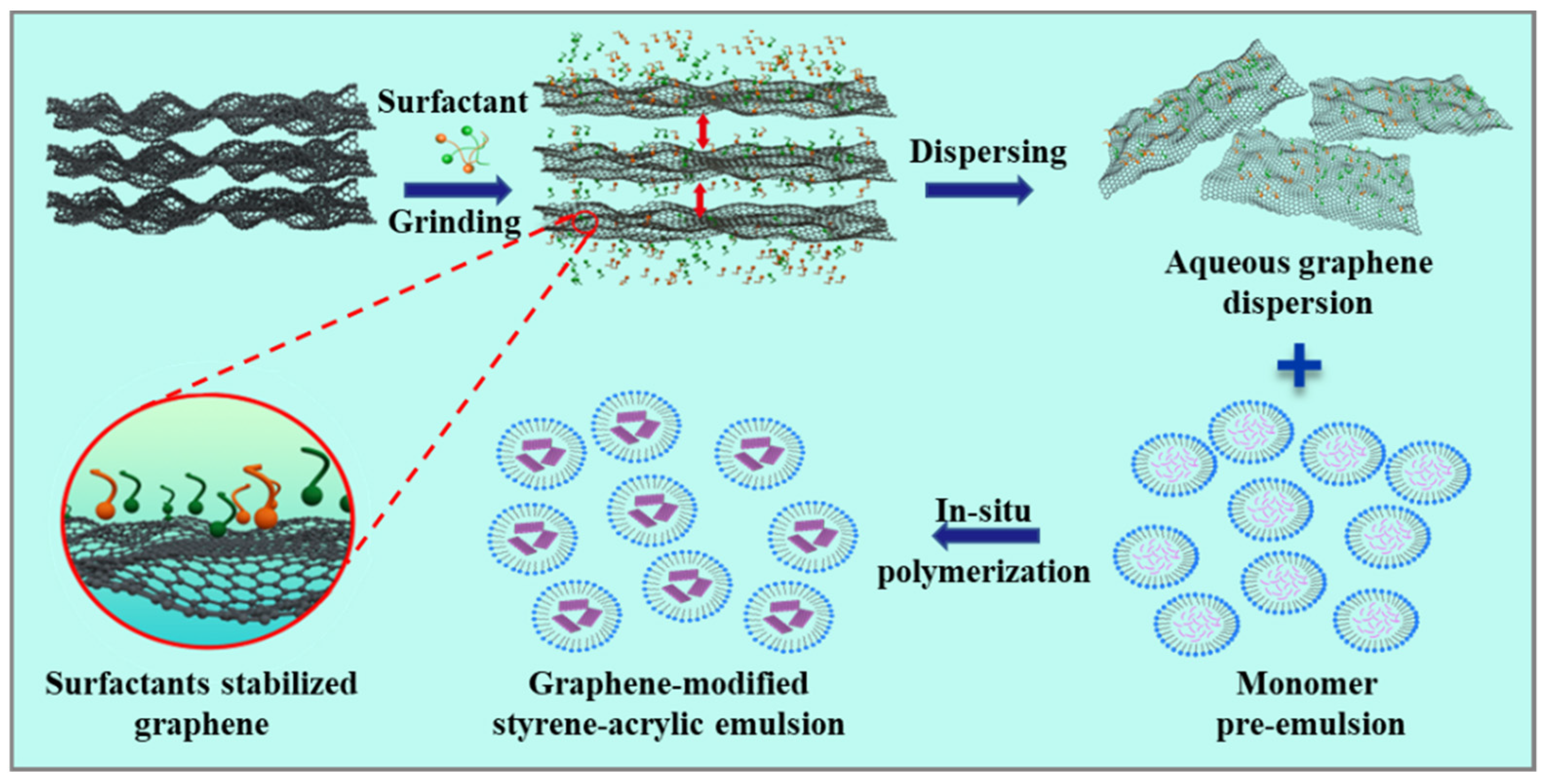
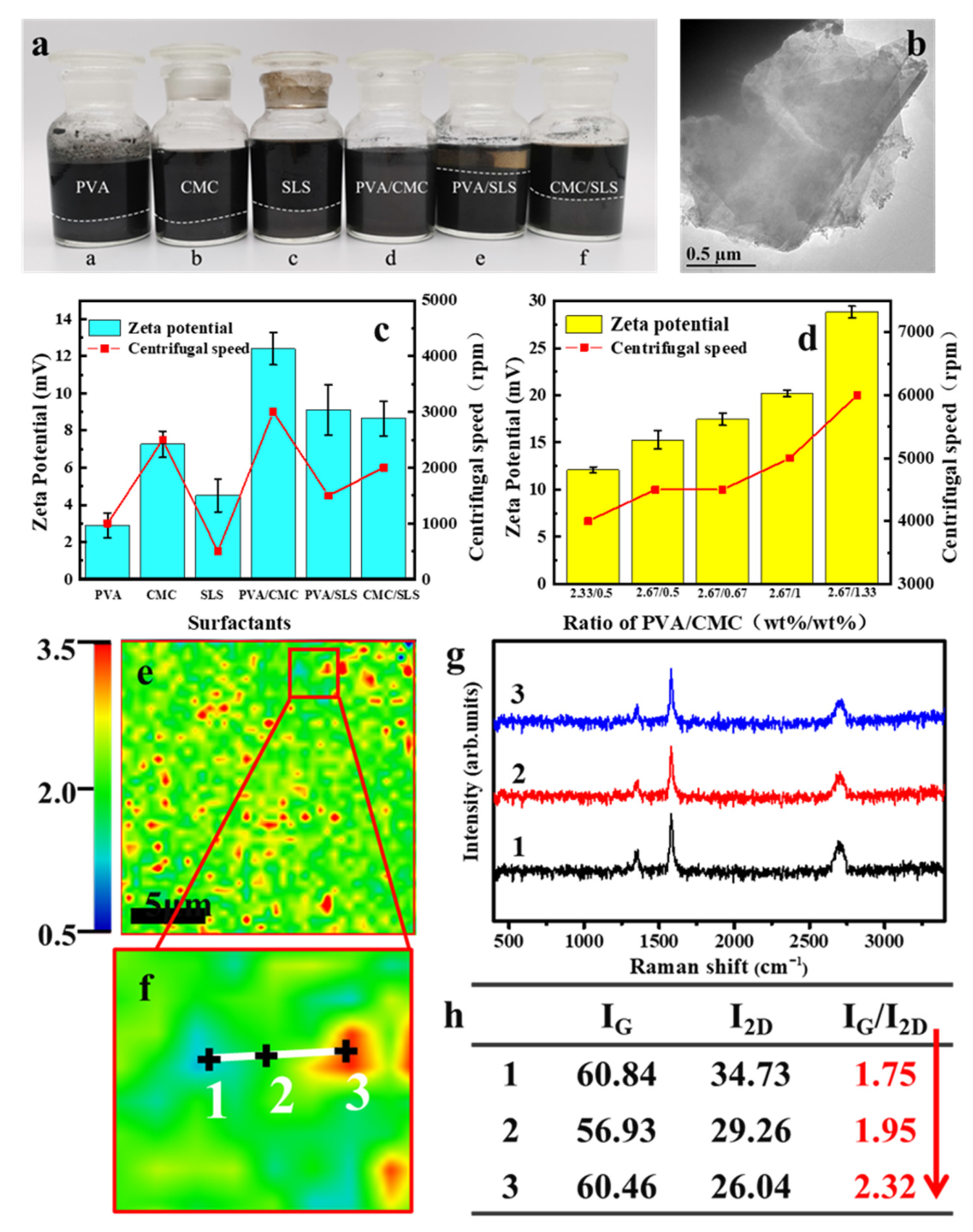
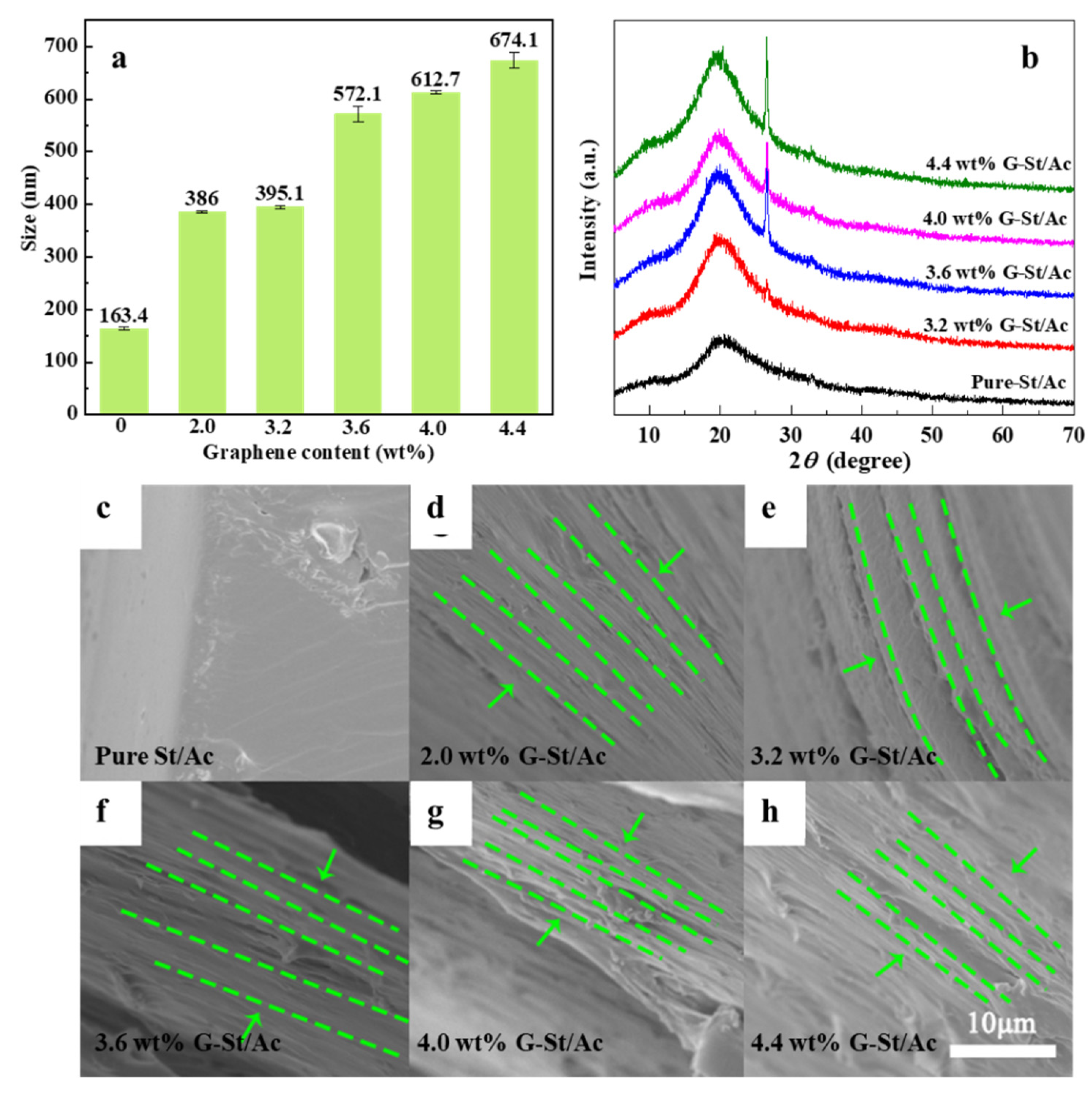
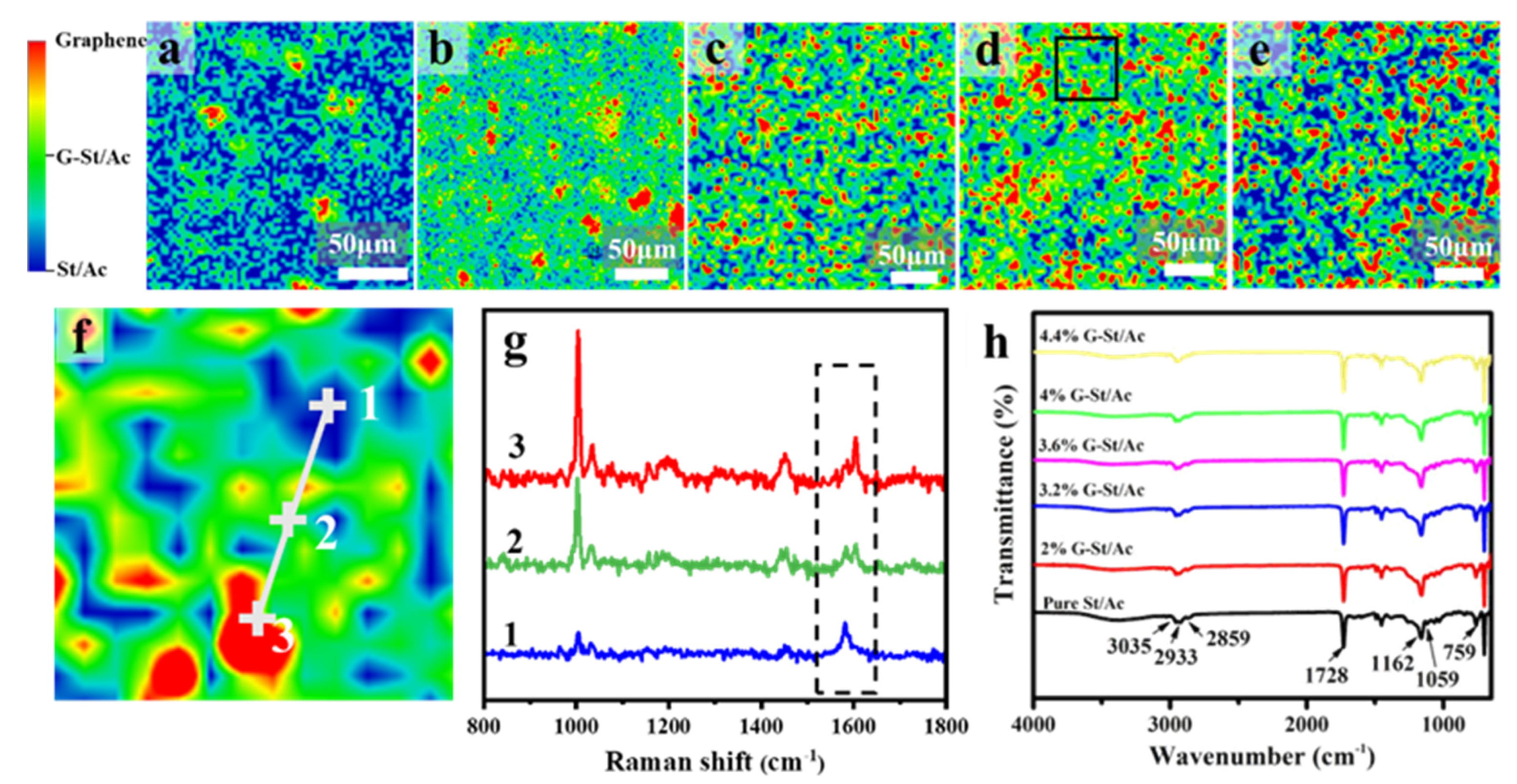
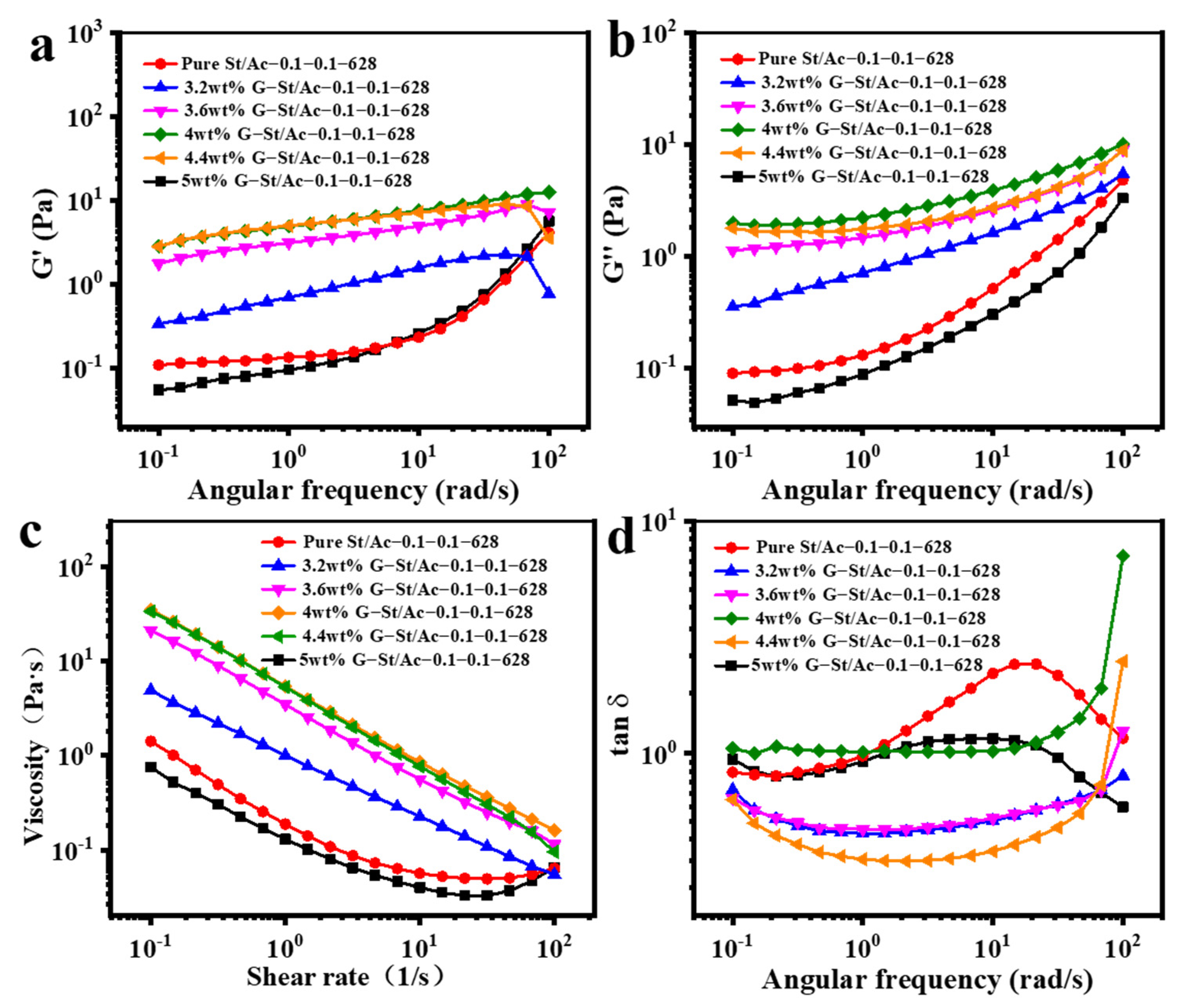
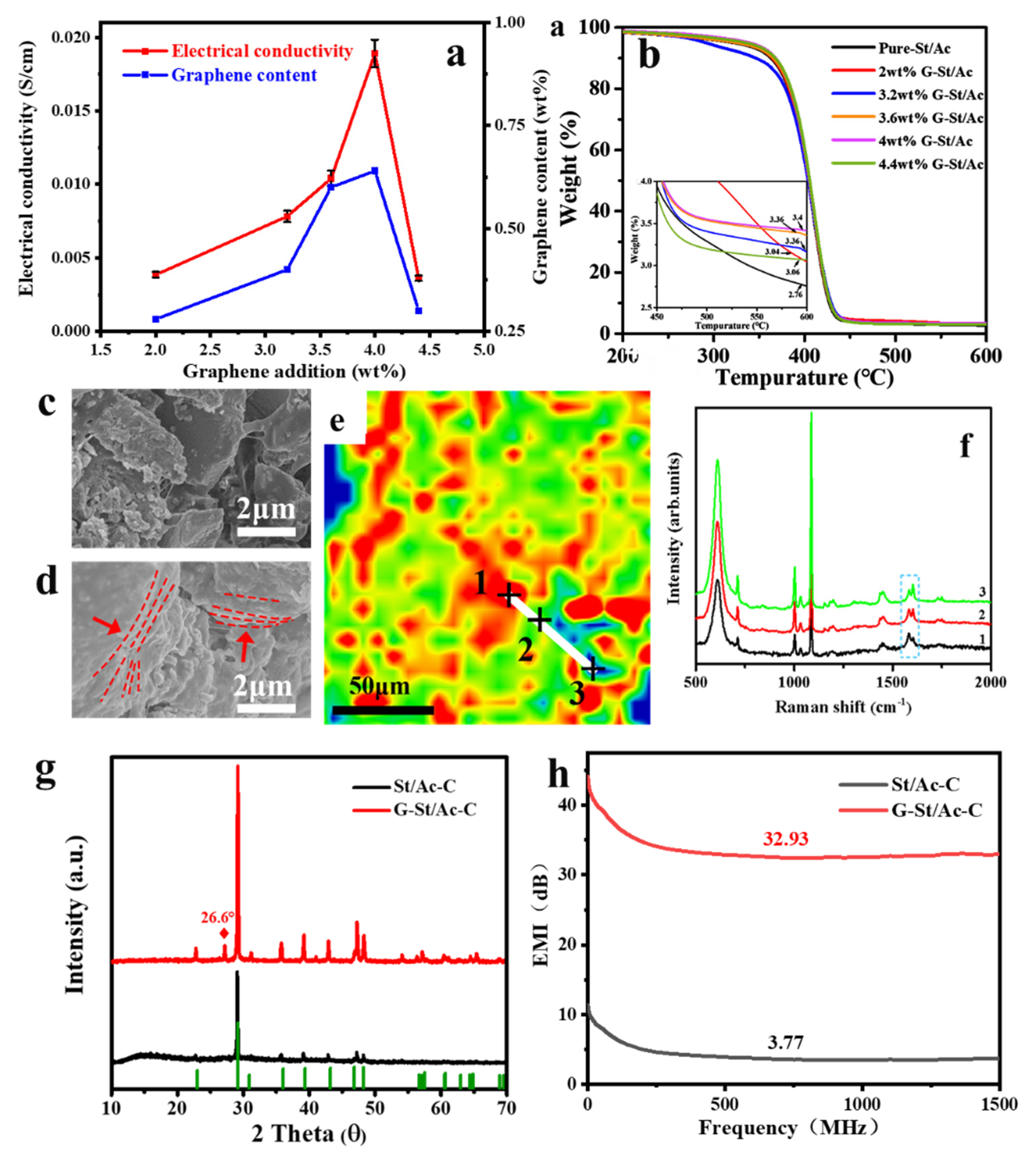
| Raw Materials | wt% | Raw Materials | wt% |
|---|---|---|---|
| Water | 22 | Water | 2.4 |
| Ethylene glycol | 1 | (Graphene-modified) styrene–acrylic emulsion | 34 |
| Thickening agent HS300 | 0.3 | Coalescing agents | 1 |
| Dispersing agent P-19 | 0.7 | Flatting agent 3020 | 0.15 |
| Wetting agent X-405 | 0.3 | Antifoaming agents 3016 | 0.15 |
| Titanium dioxide | 2.5 | Thickening agent ASE-60 | 0.2 |
| White clay (4000 mesh) | 4 | Corrosion remover 981 | 0.1 |
| CaCO3 (1250 mesh) | 32 | Total: 100.9 | |
| Hydroxyethyl cellulose (HEC) | 0.17 | ||
| Pre-mixed slurry | 79.97 | ||
Publisher’s Note: MDPI stays neutral with regard to jurisdictional claims in published maps and institutional affiliations. |
© 2022 by the authors. Licensee MDPI, Basel, Switzerland. This article is an open access article distributed under the terms and conditions of the Creative Commons Attribution (CC BY) license (https://creativecommons.org/licenses/by/4.0/).
Share and Cite
Li, Y.; Luo, J.; Huang, B.; Jin, H.; Sun, X.; Cao, C.; Chen, Q.; Qian, Q. Fabrication of Graphene-Modified Styrene–Acrylic Emulsion by In Situ Aqueous Polymerization. Polymers 2022, 14, 3763. https://doi.org/10.3390/polym14183763
Li Y, Luo J, Huang B, Jin H, Sun X, Cao C, Chen Q, Qian Q. Fabrication of Graphene-Modified Styrene–Acrylic Emulsion by In Situ Aqueous Polymerization. Polymers. 2022; 14(18):3763. https://doi.org/10.3390/polym14183763
Chicago/Turabian StyleLi, Yalin, Jieling Luo, Baoquan Huang, Hongjun Jin, Xiaoli Sun, Changlin Cao, Qinghua Chen, and Qingrong Qian. 2022. "Fabrication of Graphene-Modified Styrene–Acrylic Emulsion by In Situ Aqueous Polymerization" Polymers 14, no. 18: 3763. https://doi.org/10.3390/polym14183763
APA StyleLi, Y., Luo, J., Huang, B., Jin, H., Sun, X., Cao, C., Chen, Q., & Qian, Q. (2022). Fabrication of Graphene-Modified Styrene–Acrylic Emulsion by In Situ Aqueous Polymerization. Polymers, 14(18), 3763. https://doi.org/10.3390/polym14183763






